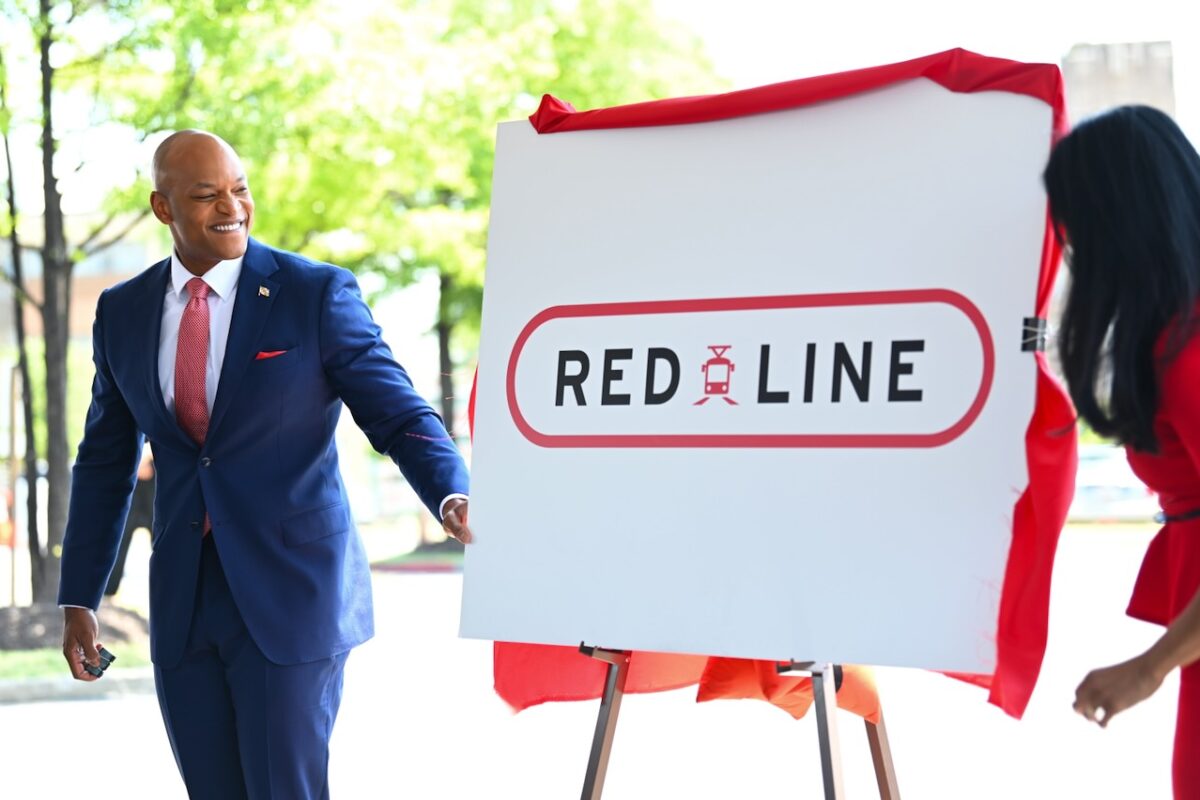
One year ago, at the West Baltimore MARC Station, then-new Governor Wes Moore announced his intention to revive planning for the east-west transit line that had been abruptly cancelled eight years prior by former Governor Larry Hogan. At the time of Moore’s pledge, two big questions remained unanswered, however.
One, would the revived project follow the original plans for a 20-plus-station light rail project between Woodlawn and the Social Security Administration in the west and John Hopkins Bayview Medical Center in the east? Or would it instead be a dedicated a bus line? And two, how would the funding for the once near-shovel ready project be restored after former Gov. Hogan sent nearly $1 billion in approved funding back to the federal government?
At a press conference at Johns Hopkins Bayview Medical Center last week, Moore announced that—following months of study and public outreach by state transportation officials—his administration has committed to building a future Red Line with light rail trains, eliminating a rapid-bus option.
“This is the right choice for Baltimore,” an energetic Moore said on Friday, June 28. “It’s the fair choice for Baltimore, and it’s the right and fair choice for the state of Maryland.
“This is a day we will celebrate for generations to come,” Moore added. It was a decision that public transit advocates had hoped and organized for after two decades of planning, studying, and navigating political hurdles.
However, while Moore acknowledged that he is optimistic that the funding puzzle will be resolved, local, state, and federal funding mechanisms remain unsolidified. Adding to the financial challenges, Maryland—which is expected to fund up to 50 percent of the project’s costs—faces major structural budget deficits. If President Joe Biden loses his reelection bid to former President Donald Trump in November, it would likely further complicate hopes for federal funding.
“I want to be very clear to the people of our state that elections do have consequences,” Moore told those gathered outside Bayview, adding that the current president’s administration “sees Baltimore” and “understands the importance of transit.”
Officials estimate the cost of the project will be anywhere between $3.2 billion to $7.2 billion, depending on the final route selected. Several light rail route options remain on the table, Maryland Transit Administrator Holly Arnold said, including one that would tunnel under Fells Point—as opposed to a slower, but less costly, completely above-ground system. The next step in the process will be more public engagement and MTA work to determine the final route.
A light rail system can carry double the number of riders and move faster than dedicated bus service. Light rail is also expected to attract more new public transit riders and spur private transit-oriented development along the route and around proposed stations. More than 70 percent of the public feedback noted a preference for light rail over dedicated bus service, Arnold said.
Maryland Transportation Secretary Paul Wiedefeld said the state could begin construction in three to four years, in the best-case scenario. Arnold said that, depending on the final route and funding, the Red Line could see its first riders in seven to 10 years. The state will begin the process of applying for funds through the Federal Transit Administration after the final route is determined.

Initially conceived in 2002, former Gov. Martin O’Malley formally approved the Red Line plans in 2009.
“I always believed once we changed administrations, the Red Line would be restarted,” said Glenn Smith, co-founder of the Baltimore Transit Equity Coalition (BTEC) and a member of the MTA’s Red Line community advisory team.
BTEC’s first major initiative was filing an administrative complaint with the U.S. Department of Transportation that former Gov. Hogan’s cancellation of the Red Line violated anti-discrimination laws established by the 1964 Civil Rights Act. Hogan eventually dispersed hundreds of millions of dollars in state funding previously designated for the Red Line for road and transportation projects in other parts of the state. BTEC’s complaint was soon followed by a suit filed by the NAACP Legal Defense Fund, which was then dismissed by the Trump Administration shortly after his election in 2016.
Smith said he was confident that the Red Line would win renewed federal funding—after Maryland U.S. Senators Chris Van Hollen and Ben Cardin secured language in the 2021 infrastructure legislation that would expedite the Red Line rail project—should Maryland and Baltimore officials choose to restart it.
“We have the best title delegation in the country and they are ensuring that we’re going to get to the front of that line,” Arnold said. “The Federal Transportation Administration also recently put out updated guidance for the capital investment, and that makes it really clear that they want to fund projects. We feel very strongly that we’re going to be a top contender for funding.”
Moore, who described the project as necessary for Baltimore and the metro area to remain competitive with other cities, said the construction of the Red Line alone was projected to bring 5,000 jobs and $10 billion in economic activity.
“The main announcement is that we’ve eliminated the dedicated bus option,” Arnold said. “It’s good progress. We’ve restarted the community advisory board. We hired an executive director for Transit Development and Delivery. We’ve hired a Red Line project director. They now have offices here. So, there are a lot of things that are happening behind the scenes, as well. The project is becoming more of a reality.”
